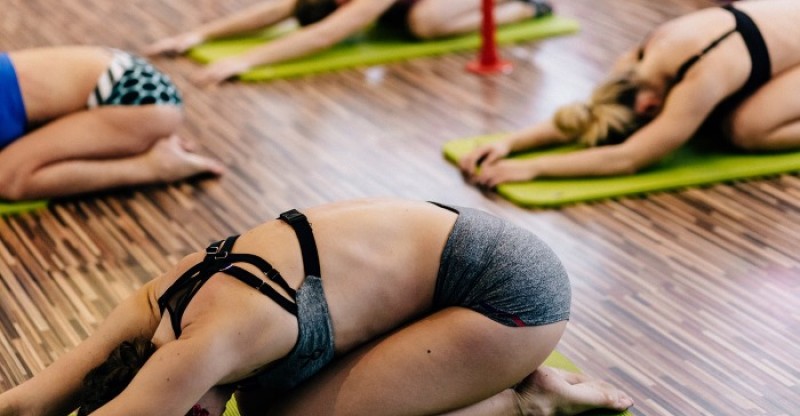Top 10 Best Yoga Poses to Relieve Back Pain
When you wake up with an achy back, you may ask yourself when your back pain even started.
The answer is three to four million years ago.
Scientists estimate that around this time early human ancestors began to walk on two feet.
This adaption was virtually unseen before in the animal kingdom, so it makes sense that it has led to back and neck troubles since that crucial evolutionary leap.
The pressure of keeping the weight of your head balanced on top of your spine is the oldest known culprit of human back pain.
Add the sedentary lifestyle that many people lead into the mix and it’s easy to see why so many people are suffering from chronic back pain.
According to the American Chiropractic Association, 80% of the population will experience a back related problem.
In fact, they claim that low back pain specifically is the greatest contributing factor to disability around the world.
For those who have experienced a serious spinal injury, or even just chronic soreness, you know how fast back pain can become incapacitating.
If that’s not enough to send you looking for a solution, consider the financial impact of back problems.
The ACA estimates that $50 billion a year is spent on back pain in the US alone.
Additionally, back pain is the second most common reason for a visit to the doctor’s office and a common reason that people miss work.
Back pain is actually the most expensive health care problem for people in the United States between the ages of 30 and 50.
Can Yoga Help?
Treating chronic pain is no doubt costly, but luckily, there seems to be concrete scientific evidence backing up claims that yoga can help to manage and treat chronic pain as well as nonspecific lower back pain.
Yoga can help to improve your posture while creating strength and flexibility that helps you to avoid injury, but that’s not all.
Check out some of these ways yoga can help you manage or treat your chronic back pain.
- Pain Management
Yoga actually helps you to increase your pain tolerance.
One study examining the neuroanatomical effects of yoga found that yogis can endure pain for twice as long as those who do not practice yoga.
Yogis were able to use a number of “cognitive strategies involving parasympathetic activation and interoceptive awareness to tolerate pain.”
Those cognitive strategies refer to the individual’s ability to distract themselves from the pain.
The strategies taught in yoga may be meditation, breath work, and many more.
The same study discovered that yogis had greater amounts of gray matter in the brain, whereas another study found that those suffering from chronic back pain had decreased gray matter density.
Gray matter in the brain encompasses the areas that control sensory perception and muscle control, among other important functions, so it’s no surprise that greater amounts of gray matter were correlated with greater pain tolerance.
The results of this study also seem to indicate that chronic back pain can literally lead to the death of brain cells, so if you’re suffering from back problems, it’s time to get this pain under control.
- Stress, Tension, & Anxiety
Those suffering from chronic back pain know that tension and stress make the pain all the worse.
Because your body is an interconnected system, tension held in the shoulders and neck can easily exacerbate your back pain and cause accompanying tension headaches.
Studies have also found that high-stress levels put you at a higher risk for suffering from chronic pain in general.
Stress is an everyday problem that most people have to deal with.
Thankfully, clinically controlled trials have found yoga to be effective in helping to treat chronic stress as well as its symptoms.
The unique combination of movement, stretching, mindfulness, and meditation you experience in a yoga class is no doubt the reason behind these benefits.
- Cost Reduction
The economic burden of chronic back pain is surprisingly vast.
If you have chronic back problems you may find that between visits to the doctor and chiropractor, medication, and massages, the cost of treating your back pain can reach into hundreds if not thousands of dollars.
Consider the amount of work you might have to miss due to the pain and you could really be in hot water.
If surgery is needed, you could even find yourself thousands of dollars in debt.
Yoga has grown in popularity as a treatment for back pain, in part, because it’s so cost-effective.
A yoga class can cost $5-$25, but you don’t have to attend a class to get the benefits of pain relief.
Practicing at home is an easy and free way to treat your chronic pain and prevent further back problems.
That being said, attending a yoga class or even having a private training with an instructor is a great way to make sure your alignment in the poses is correct.
- Massage
Yoga teaches to show our bodies love.
One way many yogis do this is through regular massage.
Thai massage is often called “yoga massage” because the massage therapist manipulates the body into yoga asanas.
Not only do massages help to reduce stress, but studies have shown that they are beneficial for those suffering from chronic back pain.
What’s more, the benefits of massage are increased when combined with regular exercise, so consider trying a massage after a yoga class.
Some yoga studios even have in-house massage therapists available.
- Mindfulness
Mindfulness practices like breathwork, meditation, and yoga have been recently studied for their therapeutic benefits.
Although more work in this field needs to be done, studies have shown some exciting scientific evidence supporting what yogis have believed for thousands of years.
Yogis will tell you that yoga cultivates a deeper awareness of the body.
After practicing yoga for a while you may find that you are more mindful, or aware, of how the way in which you move, eat and behave impacts your body.
This can help you to pinpoint triggers that make your back pain so much worse.
Triggers could be anything from the way you put your child’s stroller in the car to tension in the workplace.
Many people who have never struggled with chronic pain neglect to consider the psychological impact of living with constant discomfort or pain.
One study published by the Journal of Clinical Psychology and Psychotherapy found that when patients learned mindfulness breathwork, they saw a decrease in depression and an increase in overall well-being.
Another study noticed that implementing mindfulness programming in patients resulted in better mental health and a perceived ability to control the pain.
Common Causes of Back Pain
Back pain is such a common plight, but there are so many potential causes, it can be hard to pinpoint one.
Any of these common causes or more could be contributing to your discomfort.
- Pregnancy
Pregnancy is one of the most obvious causes of lower back pain.
The body relies on the strength of the abdomens to create balance and stability.
As a woman’s belly grows, the abdominal muscles stretch and become weak.
This destabilizes the body and puts additional strain on the lower back muscles to compensate.
Yoga is actually recommended for pregnant women to reduce stress and lower back pain.
However, not all poses are appropriate for women who are expecting, so a branch of yoga called prenatal yoga was developed specifically to help pregnant women.
- Muscle Strain
Another common cause of back pain is the muscle strain.
It’s easy to strain your muscles through overstretching, lifting heavy objects, playing sports, or even just having poor posture.
- Sedentary Lifestyle
It’s too common to spend all day sitting at your desk.
This causes compression in the spine while staring at your computer or phone can cause tension in your shoulders, neck pain, and misalignment.
A sedentary lifestyle also reduces blood flow to the discs in your spine, causing them to wear down over time.
Adding a few short yoga breaks into your workday can help to reduce the negative effects of sitting all day.
- Shoes
Wearing the wrong kind of shoes can wreak serious havoc on your spine.
Backless shoes like flip-flops allow your heels to move around, creating a lack of stability that puts undue pressure on your spine.
Stilettos are likewise a no-go.
Wearing high heels changes how your body weight is distributed, creating stress across your entire back and knees.
- Belly Fat
Considering the high stress, sedentary lifestyle that many people lead it comes as no great shock that many are carrying around a few extra pounds.
When this weight is held in the belly, it forces your pelvis to shift forward.
With the pelvis tilted out of alignment with the spine, you’re sure to feel chronic soreness.
The mindfulness cultivated through yoga can help you make sustainable changes to your diet, while yoga poses like Tadasana, help you to keep your spine aligned.
- Aging
Developing arthritis is a common symptom of aging.
You may be familiar with arthritis in the wrists or knees, but arthritis can also impact your back.
Additionally, many women suffer from osteoporosis as they begin to age.
With the loss of bone density brought on by osteoporosis, you can suffer from painful and debilitating compression fractures in your spine.
- Your Bra
Many women, especially those with larger breasts, report suffering from neck and back pain.
This can often be attributed to wearing the wrong bra.
A bra with little support, thin straps, or in the wrong size are all said to be contributing factors to back pain in women.
Best Yoga Poses for Back Pain
Attending a yoga class or retreat is a great way to challenge yourself, but you can also put together a yoga sequence from your home specifically targeting back pain.
Downward-Facing Dog (Adho Mukha Svanasana)
Downward-Facing Dog is one of the most well-known yoga poses.
This pose, or asana in Sanskrit, is meant to strengthen the entire back, helping to prevent future back pain.
It also elongates the spine and neck while encouraging a stretch in the back muscles.
Allowing your head to dangle and relax in the pose reduces tension in the neck and allows the spine to decompress.
This is a pose that can be safely done during pregnancy to relieve lower back pain.
Cat/Cow Pose (Marjaiasana/Bitilasana)
Another popular pose, the Cat/Cow sequence is well known for its powers in relieving back pain.
The “cat” aspect of the stretch is said to release tension in the neck and upper back, making Cat/Cow a great choice after you’ve been sitting at your computer all day.
The gentle back and forth movement of the pose is believed to increase spinal flexibility, so those recovering from injury or dealing with an aging spine should consider adding this pose to their routine.
Mountain Pose (Tadasana)
This yoga classic is a great way to practice your posture.
With bad posture being such a large contributing factor to back pain, this ancient pose seems tailor-made for our modern society.
Tadasana involves standing straight, breathing, and seeking to align your neck and spine.
This is an easy pose to add to your workday as a break from sitting in front of the computer.
Child’s Pose (Balasana)
This resting pose provides a stretch to your back while calming your mind, helping to relieve lower back and neck pain.
Add Child’s Pose to your yoga sequence when you need a break or an in-depth stretch.
It’s also a great choice for pregnant women looking for lower back relief.
Pigeon Pose (Eka Pada Rajakapotasana)
Pigeon Pose provides a deep stretch to your hips, thighs, and lower back.
Bringing flexibility to the hips and thighs helps to maintain proper posture and can possibly reduce sciatica related discomfort.
This pose provides a deep stretch, so you may need to use a pillow or a block to make sure you are comfortable.
Revolved Triangle Pose (Parivrtta Trikonasana)
No yoga sequence for back pain is complete without a twist.
Twists are asanas that rotate the spine.
Not only do twists help to improve balance and posture, they are also said to help relieve back pain.
When trying Revolved Triangle Pose, be sure to use your feet for stability and not to lock your knees.
Seated Forward Fold (Paschimottanasana)
This simple stretch requires you to sit straight and mindfully reach for your toes, providing a stretch to your back and hamstrings.
This is a great pose for anyone because you only have to stretch as far as you feel comfortable.
If you can’t reach your toes, loop a strap around your feet and hold on to that instead.
Rag Doll (Uttanasana)
Also known as Standing Forward Fold, Rag Dolls is a deeply relaxing pose that stretches your back, hips, and thighs.
Like Seated Forward Fold, Rag Doll can be easily modified to accommodate all experience levels.
For a deeper stretch, elevate your heels off of the ground. Or to reduce intensity, bend your knees slightly.
Fish Pose (Matsyasana)
This resting pose is often seen towards the end of yoga classes to prepare the body and mind for Savasana.
Often practiced using a block, Fish Pose brings a stretch to the throat, hips, ribs, and chest, while strengthening the upper spine.
Additionally, this pose reduces pressure on the spine and neck, making it a common counter pose for back bends.
Fish Pose also provides a stretch to your abdomen, so try this after an intense ab workout.
Remember that your abs and lower back are connected, so a weak abdomen could lead to back pain.
Eagle Pose (Garudasana)
Eagle Pose is another asana that is said to improve balance.
This challenging balancing posture brings a gentle stretch to your upper back and shoulders while potentially providing relief from sciatica.
Focus on your all too important core strength to maintain your balance in this asana.
Camel Pose (Ustrasana)
Camel Pose stretches the entire front body and increases spinal flexibility.
This backbend is used to counteract the effects of a sedentary lifestyle.
If you sit behind the wheel of your car or in front of a computer screen all day, this pose can provide some relief to a stiff neck and tense shoulders.
Camel Pose may be a powerful stretch, however, it is not ideal if you have a migraine.
If you are pregnant or have a lower back injury you may still do this pose, but you should take care not to pinch your lower back or overstretch.
Locust Pose (Salabhasana)
One of the best ways to treat lower back pain is by preventing it altogether.
In order to prevent back pain, not only do you need to reduce stress, and possibly change your lifestyle, you also need to gain strength in your abdomen and lower back.
Locust Pose is a calming asana that lengthens the entire spine while strengthening your core, back, buttox, and hamstrings.
It also provides a nice massage for your internal organs.
If done carefully, you can also use this posture to bring relief to your lower back and sciatica, however, it should not be used by pregnant women.
Legs Up the Wall Pose (Viparita Karani)
This passive pose is great for the elderly because it requires little strength or flexibility, yet has a big pay off.
This relaxing posture offers tension relief in your back and pelvic floor while delivering a much-needed stretch to your hamstrings and lower back.
To amp up these benefits, place a cushion under your hips to elevate them a few inches off of the ground.
What about Children?
Back pain is often something associated with aging and pregnancy, but that just isn’t accurate anymore.
Doctors are seeing a growing number of children experiencing back pain.
While there may be a number of factors to consider including obesity rates and sedentary lifestyles, the American Academy of Orthopedic Surgeons points towards backpacks as a culprit.
We’ve all seen kids walking home from the bus and wondered how and why they are carrying so many books.
If you have children, you should be aware of the fact that carrying a heavy backpack could lead to posture problems, pain, and more serious issues later in life.
The American Academy of Orthopedic Surgeons suggests that a backpack should not be more than 20% of a child’s weight.
If you’re worried about your child’s back, you should note that a 2010 study found that yoga is effective in treating non-specific lower back pain in children.
As an added bonus, many studies have found other benefits of yoga for children.
A 2011 study published in the Journal of Behavioral Health Services and Research assessed that secondary school children who were regularly practicing yoga showed a significantly improved ability to control anger and avoid fatigue.
A yoga studio near you may offer classes for children, but you can also start practicing with your children at home.
Cat/Cow Pose, Downward-Facing Dog, and Happy Baby Pose are all easy, kid-friendly poses you can integrate into your child’s routine for some lower back relief.
Can Yoga Help Seniors?
From arthritis to back pain, there’s plenty of aches associated with aging.
Slowly, but surely older adults have realized the benefits of yoga for the aging body.
Luckily, there’s concrete empirical research to support anecdotal evidence.
In one study, seniors citizens attended an eight-week mindfulness and meditation program, meditating about four days a week.
The results showed that regular meditation was responsible for a significant improvement in chronic lower back pain.
A composite study analyzing the findings of 318 articles on the topic of mindfulness practices and chronic pain in adults found that Yoga, tai chi, hypnosis, and progressive muscle relaxation yielded significant results in helping older adults to reduce pain.
Conclusion
The evidence seems pretty clear that there is a significant link between yoga and an ability to tolerate pain.
Some studies have shown that these same activities can even treat or prevent back pain in general.
The best way to avoid back pain is by preventing it.
Attending a yoga class can help you to reduce stress and tension as well as to bring flexibility to the spine and strength to the back.
Between discs, muscles, and nerve endings, the back and spine are pretty complicated.
Before you begin any kind of therapy, you should consult with your doctor to make sure it’s the right treatment for you.
Your doctor will probably be thrilled to hear that you are integrating both exercise and mindfulness into your wellness routine.
With the all clear from your doctor, there’s no reason not to experiment with the therapeutic benefits of yoga.
FDA Compliance
The information on this website has not been evaluated by the Food & Drug Administration or any other medical body. We do not aim to diagnose, treat, cure or prevent any illness or disease. Information is shared for educational purposes only. You must consult your doctor before acting on any content on this website, especially if you are pregnant, nursing, taking medication, or have a medical condition.
HOW WOULD YOU RATE THIS ARTICLE?






